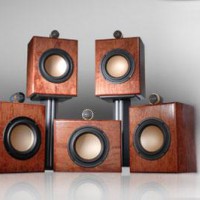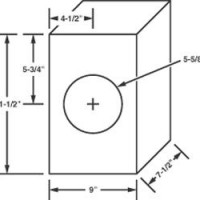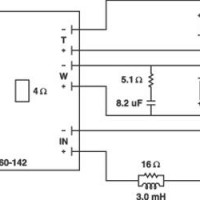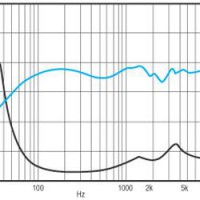SC 5.1
Designer: Tom Lawler
Project Time: 20+ hours
Project Complexity: Professional
Project Cost: $500-$1000
Driver Selection
The driver selection was much easier than determining the enclosure design. I consider myself an audiophile, so the drivers had to be accurate. I selected the Hi-Vi TN28 fabric dome tweeter because it offered accurate sound reproduction combined with styling that would allow me to imitate (and therefore flatter) the B&W 805S design. The sound pressure level (SPL) vs. frequency response graph published by Hi-Vi indicated that the TN28 was relatively flat from 2 kHz to 20 kHz, producing approximately 88 dB. I used the tweeter’s 88 dB SPL as a guide for selecting a 6″ midbass, and quickly identified the Hi-Vi M6N as an excellent candidate. Since this was my first speaker design project in many years and easily the most complex, I decided to purchase a Dayton TITSK-10K Titanic MKIII subwoofer kit. Assembly of the kit took about two hours and the subwoofer sounds fantastic. I would highly recommend simplifying any surround system design by adding the Dayton subwoofer kit!
Enclosure Design
I decided to construct the enclosures from solid cherry (hence the name SC 5.1) since I don’t like working with veneers and wanted an enclosure that was unique. This project could also be produced with 3/4″ MDF, although I would suggest using a hardwood for the internal braces. The tweeter is self-contained and is attached to the top of the enclosure. The midbass is the only speaker “inside” of the enclosure, so the volume of the box results from the characteristics of the Hi-Vi M6N. -Free air resonance frequency of the driver (Fs) = 46 Hz -Total Q (ratio of reactance to resistance) of the driver at Fs (QTS) = 0.45 -Compliance (VAS) = 0.63 cu. ft. -XMAX = 3.5mm -selected a QTC (total Q for the speaker system) of 0.9 for the enclosure design. A value of 0.9 should result in accurate sound reproduction. The remaining values can be calculated. -Compliance ratio (A) = ((QTC / QTS) x (QTC / QTS)) – 1 = 3 -Resonance frequency of the closed box (Fc) = (QTC x Fs)/ QTS = 92 Hz -Box volume (Vb) = VAS / A = 0.21 cu. ft. = 362.88 cu. in. (optimal value) Finally, WAF (Wife Approval Factor) = HIGH, therefore, the enclosure dimensions had to be as small as possible. • Internal = 7-1/2″ (W) x 6″ (D) x 10″ (H) = 450 cu. in. = 0.26 cu. ft. -External = 9″ (W) x 7-1/2″ (D) x 11-1/2″ (H) -Volume occupied by internal braces (estimated) = 66 cu. in. -Internal volume (450 cu. ft.) – volume of internal braces (66 cu. in.) = 384 cu. in. (384 cu. in. = 0.22 cu. ft., close enough to the 0.21 cu. ft. optimal value)
Amplifier/Crossover Configuration
Like my decision to purchase a Dayton Titanic MKIII Subwoofer Kit, I also decided to simplify the crossover design by selecting an existing crossover that complemented the driver selection. Dayton’s XO-2W-2.5K 2-way at 2,500 Hz is a second order 12 dB/octave crossover well suited to the SC-5.1 design, since the Hi-Vi M6N is relatively fl at up to 3,000 Hz and the Hi-Vi TN28 is good down to 2,000 Hz. Thanks to suggestions from Mike Van Den Broek and Brian Myers at Parts Express, I added a contour filter consisting of a 3.0 mH inductor paralleled with a 16 ohm non-inductive resistor, wired in series between the speaker input terminals and the Dayton crossover. They also recommended adding a conjugate filter consisting of an 8.2 uF capacitor in series with a 5.1 ohm non-inductive resistor, wired in parallel between the crossover and the woofer. And although the woofer is rated at a nominal 8 ohm impedance, they deduced that the best results are achieved by using the 4 ohm tap on the Dayton crossover.
Enclosure Assembly
I purchased 100 board-feet of solid cherry from internetlumber.com and used less than half to construct ten speakers. I had to join several 5″ wide boards to create 10″ wide sections for the front and back panels. Total cost for wood with delivery was approximately $450. MDF would be a less expensive option. Each speaker enclosure was constructed from the following parts: (2) Side panels: 11-1/2″ x 6″ x 3/4″ (1) Top panel: 9″ x 6″ x 3/4″ (1) Bottom panel: 9″ x 6″ x 3/4″ (1) Front panel: 11-1/2″ x 9″ x 3/4″ (1) Back panel: 11-1/2″ x 9″ x 3/4″ (8) Horizontal internal braces: 6″ x 3/4″ x 3/4″ (4) Vertical internal braces: 8″ x 3/4″ x 3/4″ The side panels were mitered to 45 degrees on both 6″ sides (maintaining the exterior dimension of 11-1/2″). The top and bottom panels were mitered to 45 degrees on both 6″ sides (maintaining the exterior dimension of 9″). This permitted the side panels to meet with the top and bottom panels, making a 90 degree corner. All four edges of the exterior facing sides of the front and back panels were routed with a half-over router bit. All parts were biscuit joined, glued, and screwed together to ensure a solid enclosure. Holes were pre-drilled for all wood screws. All internal seams were filled with clear silicon caulk to keep the box airtight, and the enclosures were lightly filled with Acousta-Stuf.
Conclusion
I actually built two full sets (ten speakers, total) and gave one set to my brother Kevin. He connected his to a standard Sony surround receiver and commented that the speakers were noticeably less effi cient than the Sony speakers that accompanied his receiver; in other words, the SC-5.1 speakers required more power to produce the same amount of sound as the Sony speakers. He further stated that the SC-5.1 speakers sounded amazing, were extremely detailed, and that they made the Sony speakers sound like tin cans on twine. I connected my set of SC-5.1 speakers to a new Emotiva DMC-1 processor and MPS-1 amplifi er with no previous reference speakers. My old “Hi-Fi” set was a DJ amp and two EV-1502 speakers. I’ve found the SC-5.1 to be very accurate and easy to listen to. Bass is well-developed when integrated with the previously mentioned Dayton Titanic Subwoofer. The system’s sound stage is expansive, vocals float effort lessly through the air, and cymbals and bells are presented as if they are right there in the living room. While listening to one of my favorite jazz songs, “Take Five”, I closed my eyes and was able to place the physical position of each instrument. Other listeners, including Dani (my wife), Jane (good friend), and Josh (fellow Audiophile) commented that the SC-5.1s are warm, inviting, and appear to reproduce sound effortlessly. Unfortunately, I don’t possess any audio test equipment so audition reviews will have to suffice for now.
About The Designer
Tom Lawler is a 30-something computer scientist who resides in Connecticut and is responsible for system administration, network security, and data analysis. In December of 2006, a friend gave him a copy of AudioXpress magazine and said, “I think you might be interested in this”. Tom suddenly remembered that he had loved speaker and amplifier building as a kid, and reinvested himself in the hobby. When not building speakers, he is restoring a collection of approximately seventy-five pre-war (1930-1940) vacuum tube radios. Tom’s next project will probably be a “from scratch” pushpull vacuum tube amplifier using NOS Raytheon 6336B tubes (30 watt dual triodes), which will of course lead to another speaker project to complement the tube amplifier.





Those are beautiful!! Would love more pictures of the final product. The cherry looks GREAT! What stain did you use? Also, could this design allow the tweeter to be installed in the box somehow?
Beautiful project, it has me wanting to replace my speakers